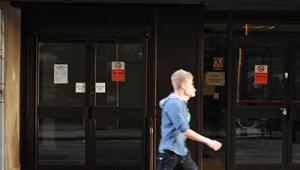By Claudia Wood | November 26 2014

The government is talking up welfare cuts, with renewed appeals to ‘hard-working taxpayers’. But rising poverty, and changes to in-work benefits, could make it a reform too far.
At this time of year, the media will inevitably publish a handful of seasonal social policy stories – covering the latest statistics or analysis related to the rise in child poverty, fuel poverty, social isolation, homelessness and the use of food banks in the UK – giving readers sobering insights into the lives of those whose festive season will be grim.
In the past few weeks alone, we have been told that benefits delays and sanctions are among the primary reasons that more than half a million people are now resorting to emergency parcels from food banks, and that Unicef despairs of our global child poverty rankings and links our recent slide down the tables to stagnating wages and austerity measures.
Then the Social Mobility and Poverty Commission reported that 600,000 more children are living in ‘absolute poverty’ (defined as below 60% of median income) than when the coalition came to power. It predicts that 2010-2020 will be the first decade since records began that will see a rise in absolute poverty.
The University of Oxford has also cast doubt on the government’s employment figures, claiming that it seems to have ‘lost’ half a million Jobseeker’s Allowance claimants from the books – unemployed people whose JSA claims were closed shortly after being sanctioned, and who now do not appear in either employment or unemployment figures. Perhaps they’ve simply joined the back of the food bank queue, but you wonder how these people will be surviving this Christmas while the rest of us are carving the turkey.
With this in mind, the timing of the government’s roll-out of the new annual tax statement could not have been better. Providing a hard pecuniary counterpoint to all the seasonal sentimentality, the tax statements provide us ‘hard-working taxpayers’ with a visual illustration of how our taxes are being spent – with pie charts and tables that would have pleased Ebenezer Scrooge had he had more than scales and a ledger in his day. Examples released by the Treasury told the public that if they earn £30,000 a year, £1,663 of their taxes goes to welfare, £1,280 to health, £892 to education, £822 to state pensions, and so on.
These illustrations provoked widespread criticism when it was pointed out that the data had been misrepresented to suggest a far larger proportion of people’s earnings is spent on welfare than is actually the case. Breakdowns floated by the Treasury in 2012 gave more detail – showing, for example, that only 3% of welfare spending goes towards unemployment benefits, and much more on older people and working adults. But in an effort to ‘simplify’ the data, the 2014 versions contain no such breakdowns – with JSA, tax credits, Child Benefit, Pension Credit etc all lumped together.
More importantly, the welfare category includes areas of spending few would describe as ‘welfare’: £28.5bn of personal social services – the care and support commissioned by local authorities for older and disabled people – and £20bn of public sector pensions. In total, the social researcher Declan Gaffney estimates the ‘welfare’ category has been inflated by 40% due to these added extras. This use of data has been seen as highly political, part of the government’s welfare reform agenda. It is one thing, critics said, that the government manipulates benefits statistics for media consumption – encouraging public hostility towards so-called benefits scroungers. It is entirely another to use official government data bulletins – at a cost of £5m a year – to perpetuate the same myth.
But who could blame the government? Never has public support been more crucial for welfare reform. In the wake of successive poverty, homelessness and food bank statistics, all pointing to stagnating wages and welfare reform as the key drivers for their increase, Chancellor George Osborne has announced that if re-elected in 2015, the Conservatives will cut welfare spending by a further £12bn in the following two years. Perhaps with the new tax statements, quarterly welfare fraud bulletins and some well-timed press releases about the ‘outrageous’ excuses people give for not being fit for work, the government might gain enough public support to carry through further cuts – such as the two-year freeze on benefits and tax credits the chancellor suggests will contribute £3bn of the £12bn spending reduction he needs.
But this certainly isn’t a done deal. The government is under increasing fire for mishandling the existing programme of cuts – even among those who support public spending cuts in principle – making the further cuts agenda a tough sell. This is because, if there’s one thing the tabloid-reading public disapprove of more than benefits scroungers, it’s a government wasting their taxes on failed IT systems.
The error-strewn roll out of Universal Credit has captured many headlines. It has seen Iain Duncan Smith’s Department for Work and Pensions write-off £40m in failed IT software, with an additional £91m predicted to be lost over the next few years. There were supposed to be a million households on Universal Credit by the end of this year, but just over 17,000 were receiving the benefit by the end of October.
It is not just this ambitious new benefit scheme which is in chaos. The Public Accounts Committee has also been scathing regarding the administration of cuts to both the Employment and Support Allowance and the Disability Living Allowance. It reported that many disabled people have been facing six-month delays before receiving their new Personal Independence Payment, which replaces DLA. Shockingly, terminally ill people are waiting a month on average, 180% longer than was estimated. The reassessment programme is creaking under a backlog of 780,000 claims.
Speaking of backlogs, more than 700,000 people are still waiting for work capability assessments in order to claim ESA. The company charged with operating this system, Atos, is ending its contract early as a result. Its replacement, Maximus, estimates that it will take 18 months for the backlog to be cleared. Add to these delays the errors in assessments – costing £60m in work capability appeals each year alone, as 40% of decisions are being overturned – and we have a clumsy and costly mishandling of welfare reform.
If the government risks spending more in botched administration than it saves in cuts to the benefits bill, then it will need all the public support it can get for an election platform built on more of the same. Especially when it’s clear that the additional £12bn cannot be achieved by the continued salami slicing of the same out-of-work benefits. The big – and controversial – new frontier of welfare reform after the election will be ‘in-work conditionality’.
In-work conditionality will see tax credits, Housing Benefit and other benefits claimed by working adults on low incomes become conditional on one’s salary. If someone does not earn the equivalent of the minimum wage, and/or works fewer than 16 hours a week, they may be deemed to not be working ‘enough’ to be entitled to in-work benefits support. Trials have begun in Northwest England to remove benefits from part-time workers who refuse to take on extra hours.
This is a hugely significant shift in approach – where people who are in employment will be put into the same bracket as those unemployed ‘scroungers’ we keep reading about. Part-time and low-paid workers will be the biggest target group – disproportionately more likely to be women, young people, and working in the hospitality or caring sectors. The self-employed, too, may fall foul of the rules and have their Universal Credit docked if they cannot get enough work to meet the earnings threshold in a slow month.
With this in mind, it is worth considering how the UK population is dragging itself out of the downturn: with significant increases in informal, part-time work and self-employment – a trend which has seen more people in work, but wages stagnate. Self-employment is now at a 40-year high, accounting for 15% of the workforce, but the average income from self-employment has fallen by 22% since 2008/09.
Recent analysis by the TUC found that only one in every 40 of the net jobs added to the economy between 2008 and 2014 has been as a full-time employee, while 24 in every 40 have been self-employed, and 26 in every 40 have been part-time. There are now 1.4 million ‘zero hours’ contracts, with no guaranteed minimum hours or pay, while the proportion of jobs that do not comply with National Minimum Wage legislation has risen from 0.4% in 2000 to 2% in 2012. This all adds up to in-work conditionality having disastrous impacts on workers whose employers refuse to increase hours or pay, or whose income is entirely dependent on the work they can drum up in construction, window cleaning or mini-cabbing.
Yet these are exactly the sorts of ‘hard-working taxpayers’ whose support the government relies on to push through cuts to out-of-work benefits. Making a target of these people – many under-employed not by choice but by economic circumstances – will be a much tougher sell, and might explain why a mass mail-out with over-egged ‘welfare’ figures was seen as so necessary a way to spend £5m. But as media attention grows not only on the ‘seasonal’ stories of hardship and poverty, but also on the government’s mismanagement of welfare reform, will it be enough to convince the hard-working and undervalued trades and the self-employed to back this new round of cuts?
Claudia Wood is chief executive at the thinktank Demos.
This feature was first published in the December edition of Public Finance magazine



















